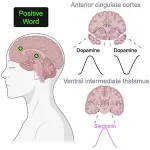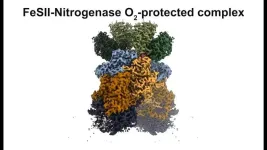(Press-News.org)
In an unprecedented new study in the journal Cell Reports, researchers have shown neurotransmitters in the human brain are released during the processing of the emotional content of language, providing new insights into how people interpret the significance of words.
The work, conducted by an international team led by Virginia Tech scientists, offers deeper understanding into how language influences human choices and mental health.
Spearheaded by computational neuroscientist Read Montague, a professor of the Fralin Biomedical Research Institute at VTC and director of the institute’s Center for Human Neuroscience Research, the study represents a first-of-its-kind exploration of how neurotransmitters process the emotional content of language — a uniquely human function.
The discovery, now online and slated for the Jan. 28 issue of Cell Reports, bridges the biological and the symbolic, linking neural processes that likely have evolved for survival in a vast array of species over the eons to the richness of human communication and emotion.
“The common belief about brain chemicals, like dopamine and serotonin, is that they send out signals related to the positive or negative value of experiences,” said Montague, co-corresponding and co-senior author of the study. “Our findings suggest that these chemicals are released in specific areas of the brain when we process the emotional meaning of words. More broadly, our research supports the idea that the brain systems that evolved to help us react to good or bad things in our environment might also play a role in how we process words, which are just as important for our survival.”
The researchers are the first to simultaneously measure dopamine, serotonin, and norepinephrine release in humans in the context of the complex brain dynamics behind how people interpret and respond to language.
“The emotional content of words is shared across multiple transmitter systems, but each system fluctuates differently,” Montague said. “There's no single brain region handling this activity, and it's not as simple as one chemical representing one emotion.”
Neurochemical measurements were taken in patients undergoing deep brain stimulation surgery for treatment of essential tremor, or for the surgical implantation of leads to monitor seizures in epilepsy patients. The procedures target distinctly different brain regions – the thalamus and the anterior cingulate cortex, respectively.
While emotionally charged words were displayed on a screen, measurements were taken using carbon fiber electrodes in the thalamus, alongside traditional platinum-iridium electrodes in the anterior cingulate cortex.
The researchers discovered the words — positive, negative, or neutral — modulate neurotransmitter release. By measuring the sub-second dynamics of the releases, they identified distinct patterns tied to emotional tone, anatomical regions, and which hemisphere of the brain was involved.
“The surprising result came from the thalamus,” said William “Matt” Howe, an assistant professor with the School of Neuroscience of the Virginia Tech College of Science. “This region hasn't been thought to have a role in processing language or emotional content, yet we saw neurotransmitter changes in response to emotional words. This suggests that even brain regions not typically associated with emotional or linguistic processing might still be privy to that information. For instance, parts of the brain responsible for mobilizing movement might benefit from having access to emotionally significant information to guide behavior.”
While the primary discovery was made in humans, validation in animal models provided additional confidence in the results.
Alec Hartle, a co-first author of the study and a School of Neuroscience doctoral student in Howe’s lab, conducted experiments in rodent models using a technique called optogenetics to confirm the patterns seen in humans. By using light to control genetically modified cells, it allowed scientists to study the functions of specific neurons and neural circuits.
“What we observed in the human brain was extraordinary,” said Howe, co-corresponding and co-senior author of the study. “The validation in animals supports and solidifies the broader implications of these neurotransmitters in decision-making systems.”
The new findings build on a recent study released in Nature Human Behavior, in which the research group highlighted dopamine and serotonin’s roles in social behavior.
“While previous studies focused on neurotransmission during decision-making, this research explores something uniquely human: the emotional content of written words,” said Seth Batten, first author of the study and a senior research associate with the Montague laboratory. “Unlike animals, humans can understand words, their context, and meaning. The study examines how neurotransmitter systems process words with different emotional weight, reflecting the hypothesis that these systems, which evolved to keep us alive, now also help interpret language.”
While still in early stages, the study's significance lies in its foundational nature and the questions it inspires for future research.
The words used in the study were drawn from the Affective Norms for English Words (ANEW) database, which rates words by positive, negative, or neutral emotional valence.
END
A recent study published in Health Data Science, led by Dr. Fengyu Wen from the Institute of Medical Technology at Peking University Health Science Center and Professor Luxia Zhang from the National Institute of Health Data Science at Peking University, reveals significant survival disparities among cancer patients depending on their mobility patterns for medical care.
The study analyzed data from over 20,000 cancer patients in Shandong Province, China, to assess the impact of intra-city, local center, and national center mobility patterns on survival rates. Patients who traveled to local or national healthcare centers had higher five-year survival ...
Getting a good night’s sleep is a critical part of our daily biological cycle and is associated with improved brain function, a stronger immune system, and a healthier heart. Conversely, sleep disorders like insomnia and sleep apnea can significantly impact health and quality of life. Poor sleep often precedes the onset of neurodegenerative diseases and is a predictor of early dementia.
New research appearing in the journal Cell describes for the first time the tightly synchronized oscillations in the neurotransmitter norepinephrine, ...
LA JOLLA (January 8, 2025)—Human bodies defend themselves using a diverse population of immune cells that circulate from one organ to another, responding to everything from cuts to colds to cancer. But plants don’t have this luxury. Because plant cells are immobile, each individual cell is forced to manage its own immunity in addition to its many other responsibilities, like turning sunlight into energy or using that energy to grow. How these multitasking cells accomplish it all—detecting threats, communicating those threats, and ...
January 8, 2025—Marked variation in the prevalence of depression was found in a multisite sample of community-dwelling older adults in the United States reports a study by Columbia University Mailman School of Public Health. Until now, few studies, have examined the frequency of depression in community-dwelling older adults in the U.S. The study is published in the Journal of American Geriatrics Society.
Of the 2,900 participants studied, 6.2 percent had depression. Older adults who had a negative history of depression or had annual household incomes of $50,000 or greater were at significantly decreased ...
PROVIDENCE, R.I. [Brown University] — Amid the many mysteries of quantum physics, subatomic particles don’t always follow the rules of the physical world. They can exist in two places at once, pass through solid barriers and even communicate across vast distances instantaneously. These behaviors may seem impossible, but in the quantum realm, scientists are exploring an array properties once thought impossible.
In a new study, physicists at Brown University have now observed a novel class of quantum particles called fractional excitons, which behave in unexpected ways and could significantly ...
About The Study: The results of this economic evaluation suggest that cardiovascular polypill treatment (single pill containing a statin and 3 half-standard dose antihypertensives) could be a high value intervention for a low-income, majority Black population with limited access to health care services. It could additionally reduce health disparities.
Corresponding Author: To contact the corresponding author, Ciaran N. Kohli-Lynch, PhD, email ciaran.kohli-lynch@northwestern.edu.
To access the embargoed study: Visit our For The Media ...
About The Study: In this prognostic study, with the use of a statistical modeling approach, the Florey Dementia Index was developed and validated to predict the onset age of mild cognitive impairment and Alzheimer dementia. This tool may be useful in organizing health care for older adults with cognitive decline or dementia and in the future may help prioritize patients for the use of disease-modifying monoclonal antibody drugs.
Corresponding Authors: To contact the corresponding authors, email Yijun Pan, PhD (yijun.pan@unimelb.edu.au) ...
NEW YORK, NY (Jan. 8, 2025)--Using a new artificial intelligence method, researchers at Columbia University Vagelos College of Physicians and Surgeons can accurately predict the activity of genes within any human cell, essentially revealing the cell’s inner mechanisms. The system, described in the current issue of Nature, could transform the way scientists work to understand everything from cancer to genetic diseases.
“Predictive generalizable computational models allow to uncover biological ...
Nitrogen is an essential component in the production of amino acids and nucleic acids — both necessary for cell growth and function. Although the atmosphere is composed of nearly 80% nitrogen, this nitrogen is in the form of dinitrogen (N2), which cannot be processed by most organisms. Atmospheric nitrogen must first be converted, or “fixed,” into a form that can be used by plants, often as ammonia.
There are only two ways of fixing nitrogen, one industrial and one biological. To better understand a key component of the biological process, University of California San Diego Professor of Chemistry and Biochemistry Akif Tezcan and Assistant Professor of Chemistry ...
A new study has unravelled the hidden mechanics of how earthquakes ignite, shedding light on the mysterious transition from quiet, creeping motion to the violent ruptures that shake the Earth. Using cutting-edge experiments and innovative models, the research reveals that slow, silent stress release is a prelude and a necessary trigger for seismic activity. By incorporating the overlooked role of fault geometry, the study challenges long-held beliefs and offers a fresh perspective on how and when earthquakes begin. These findings not only deepen our understanding of nature’s ...




